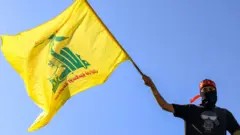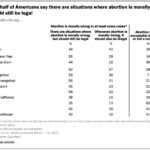Hezbollah, a significant Shia Muslim political and military force in Lebanon, and Israel have a history marked by intense and recurring conflicts. Backed by Iran, Hezbollah staunchly opposes Israel’s existence and has engaged in numerous violent confrontations. Designated as a terrorist organization by Israel, the United States, and the United Kingdom, among others, Hezbollah’s actions have profound regional implications. The latest surge in conflict began in October 2023, triggered by Hezbollah’s rocket launches into Israel following the outbreak of the Gaza war, acting in solidarity with Hamas. Israel responded forcefully, initiating a series of strikes that have dramatically escalated into a wider conflict, particularly intensifying in September 2024.
 AFP A masked demonstrator waves a flag of the Lebanese Shiite movement Hezbollah during a demonstration
AFP A masked demonstrator waves a flag of the Lebanese Shiite movement Hezbollah during a demonstration
Israel’s stated objective for its intensified bombing campaign and subsequent ground incursions into Southern Lebanon is to ensure the safe return of tens of thousands of Israeli citizens displaced from their homes due to persistent Hezbollah rocket attacks. However, these military actions have resulted in severe consequences for Lebanon, leading to widespread devastation and a significant weakening of Hezbollah’s capabilities.
Reports indicate that the conflict has tragically resulted in approximately 4,000 deaths in Lebanon, a significant portion of whom were civilians. Furthermore, over a million Lebanese citizens have been displaced since October 8, 2023, creating a massive humanitarian crisis. Israel has reported its own losses, stating that 45 Israeli civilians and 75 soldiers have been killed in the conflict up to November 2024. A ceasefire agreement, brokered on November 27, mandated the withdrawal of both Hezbollah and Israeli forces from Southern Lebanon, with an initial deadline of January 26, later extended to February 18.
The Genesis of Conflict: Hezbollah’s Rise and Anti-Israel Stance
Hezbollah emerged from the crucible of Shia militias formed to resist the Israeli invasion of Southern Lebanon in 1982, during the tumultuous Lebanese civil war (1975-1990). The name “Hezbollah” translates to “Party of God” in Arabic, reflecting the group’s ideological underpinnings. Officially announcing its formation in 1985, Hezbollah’s initial manifesto called for the establishment of an Islamic government in Lebanon and declared that its struggle against Israel would only cease with Israel’s complete removal.
Hezbollah’s military actions against Israeli forces are widely acknowledged within Lebanon as pivotal in compelling Israel to end its 18-year occupation of Southern Lebanon in 2000. Lebanon commemorates Israel’s withdrawal as a national holiday, “Resistance and Liberation Day.” Despite the withdrawal, Hezbollah maintained its armed presence in Southern Lebanon and resisted calls to disarm. Both Hezbollah and the Lebanese government disputed the UN’s assessment that the Israeli withdrawal was complete, citing unresolved border areas as still under occupation, leading to continued sporadic clashes with Israeli forces.
A major escalation occurred in July 2006 when Hezbollah launched a cross-border attack, provoking a large-scale Israeli military response. The ensuing 34-day war resulted in the deaths of over 1,125 Lebanese, predominantly civilians, alongside 119 Israeli soldiers and 45 civilians. Subsequently, UN Security Council Resolution 1701 was unanimously adopted, aiming to end hostilities and establish a buffer zone between Israel and Lebanon. The current ceasefire agreement is rooted in this resolution. Resolution 1701 mandated the disarmament of non-state armed groups in Lebanon and their withdrawal north of the Litani River, approximately 30km from the Blue Line, the unofficial border. This area was to be free of armed personnel except for Lebanese authorities and UN peacekeepers.
Despite declaring victory in the 2006 war, Hezbollah did not comply with Resolution 1701’s disarmament provisions and significantly expanded its military infrastructure in Southern Lebanon. Lebanon has consistently accused Israel of violating the resolution through military overflights. Supported by Iran through funding, training, and weaponry, Hezbollah’s military capabilities grew to surpass even those of the Lebanese army. While Hezbollah’s 2009 political manifesto shifted away from explicitly calling for an Islamic government, it reaffirmed its rejection of any compromise with or recognition of Israel’s legitimacy. Furthermore, Hezbollah’s involvement in the Syrian civil war, supporting President Bashar al-Assad from 2013 onwards, provided valuable combat experience to its fighters. Hezbollah has also been implicated in various bombings and plots targeting Jewish and Israeli interests globally.
Leadership in Flux: The Impact of Targeted Strikes
The recent conflict has significantly impacted Hezbollah’s leadership structure. Hassan Nasrallah, the long-time leader of Hezbollah since 1992, was reportedly killed in an Israeli airstrike in September 2024. Nasrallah was instrumental in shaping Hezbollah into both a formidable military and political entity, highly revered by his followers and maintaining close ties with Iran’s leadership. His long absence from public appearances was attributed to security concerns and the threat of Israeli targeting.
Following Nasrallah’s reported death, Hezbollah announced Naim Qassem, his deputy, as the new leader in late October. Other senior Hezbollah figures, including Hashem Safieddine, considered a potential successor to Nasrallah, were also reportedly killed in Israeli attacks, signaling a significant disruption to the group’s command structure.
Assessing Hezbollah’s Military Strength Post-Conflict
Hezbollah’s current military strength is difficult to ascertain precisely, having endured substantial losses in the recent conflict. Prior to the November ceasefire, a significant portion of its infrastructure was destroyed, its weapons arsenal depleted, and a considerable number of fighters were killed. The changing geopolitical landscape, particularly the stabilization of Bashar al-Assad’s regime in Syria, may also affect Hezbollah’s logistical and operational capabilities, as Syria had served as a crucial conduit for Iranian support.
Previously, Hezbollah was regarded as one of the most heavily armed non-state military organizations globally. In 2021, Hezbollah claimed to possess 100,000 fighters, although independent estimates ranged between 20,000 and 50,000. Preceding the recent escalation, it was estimated to possess a vast arsenal of 120,000 to 200,000 rockets and missiles, according to the Center for Strategic and International Studies. This arsenal primarily consisted of short-range, unguided rockets, but also included more sophisticated anti-aircraft and anti-ship missiles, and guided missiles capable of reaching deep into Israeli territory.
Shifting Political Dynamics in Lebanon
The conflict has precipitated political shifts within Lebanon. Joseph Aoun, the former head of the Lebanese army, was appointed president in January 2025, succeeding a two-year presidential vacuum. His appointment, despite Hezbollah’s preference for another candidate, signals a potential shift in political alignments. Aoun has publicly committed to ensuring the Lebanese state’s monopoly on bearing arms, a clear reference to Hezbollah’s independent military power. Furthermore, the post-war cabinet led by Prime Minister Nawaf Salam excludes Hezbollah, although it maintains religious proportionality and includes Hezbollah’s ally, Amal, with four ministerial positions. The US has also signaled a firm stance against Hezbollah’s inclusion in the Lebanese government.
Even before the recent conflict, Hezbollah’s influence within Lebanon was challenged by severe economic and political instability, including a crippling economic crisis and pervasive corruption. Lebanon has faced prolonged periods without a functional government. Despite divisions within the country regarding Hezbollah, the group wielded considerable influence, holding cabinet positions since 2005 and providing extensive social services. Hezbollah has historically enjoyed significant support, particularly among Shia Muslims, who view it as a resistance force against Israel. However, this support is not uniform across Lebanon’s diverse religious landscape, with substantial opposition from non-Shia communities.
